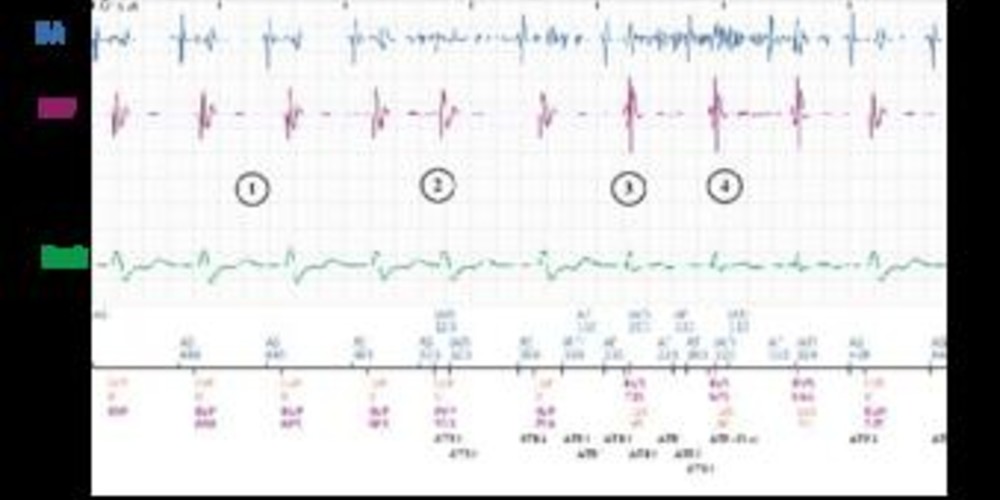Noise on the atrial channel, inappropriate mode switch and PMT
Tracing
Manufacturer Boston Scientific
Device CRT
Field Management of atrial arrhythmias
N° 7
Patient
Patient 1 : A 56-year old man with a history of severe ischemic cardiomyopathy and left bundle branch block implanted with a triple-chamber Boston Scientific Autogen CRT-D which registered a mode switch in the memory (RTA).
Patient 2 : A 71-year old man implanted with a triple chamber Boston Scientific Autogen CRT-D reveals an episode of PMT during device interrogation.

Graph and trace
Patient 1
- atrial sensing and biventricular stimulation.
- noise oversensing on the atrial channel with acceleration of biventricular stimulation (synchronized with atrial activity classified as AS).
- marked oversensing on the atrial channel with intervals classified as AF (atrial fibrillation) which result in loss of ventricular resynchronization; sinoatrial activity is followed by intrinsic ventricular activity.
- after 8 atrial cycles at a rate higher than the maximal tracking rate (entry counter programmed at 8 cycles) the entry counter is completed which triggers onset of the duration (ATR-Dur).
- after 8 ventricular cycles (duration programmed at 8 cycles), switch to asynchronous mode (ATR-FB);
- after the end of oversensing, the exit counter is completed (programmed at 8 cycles) and the devices switches back to a synchronous mode.
Patient 2
- atrial detection and biventricular stimulation.
- noise on the atrial channel leading to premature biventricular stimulation.
- retrograde conduction with onset of pacemaker-mediated tachycardia at maximal tracking rate.
- diagnosis of PMT and increase of PVARP to 500 ms during one single cycle.
- termination of the PMT.
Other articles that may be of interest to you







The first EGM indicates the importance of systematically checking the defibrillator’s memory for incorrectly diagnosed atrial arrhythmias. This mode switch was inappropriate and occurred in the context of noise oversensing on the atrial channel. In a patient with preserved atrioventricular conduction, this dysfunction can result in a decline in the percentage of biventricular pacing. In dependent patients, intermittent noise oversensing may result in acceleration in the biventricular pacing rate which could cause palpitations. On the second EGM, the noise oversensing is responsible for triggering a PMT episode.
The integrity of the atrial lead is an indispensable condition for the proper functioning of the device. In these two patients, the frequency and possible repetition of mode switch episodes and PMT will dictate the course of action and decide on the need to replace the atrial lead.